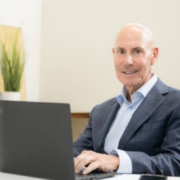Entrepreneurship Is DNA
What makes an entrepreneur successful? The multi million dollar question. In a marketplace where so many businesses fail, what traits drive success? And why do companies with solo founders do so much better – surviving longer, and generating more revenue, than their counterparts? Underneath the simple answers – vision, ambition, perseverance – lies the nuance that articulates how success is truly born.
“It’s a personality trait. It’s either there or not. It is a combination of work ethic and self motivation.”
Richard Schenkel
There are four key traits that make an entrepreneur – four essential pieces to entrepreneurial DNA and spirit.
Perseverance
The first is perseverance – they keep going when others give up. In every success story, there’s a moment when the founder could have quit. They could have said, this is too hard, or too complex, and walked away. Every business runs into snags, into situations you didn’t necessarily plan for.
Entrepreneurs are compelled to solve those tough problems. They’re 100% committed because it’s not just a job to them, it’s a mission. When you have that conviction, it drives you to persevere.
Gut Instinct
The second key trait is relying on gut instinct. It is imperative that entrepreneurs are not easily swayed by other people’s negativity. Because when you’re doing something no one has done before, disrupting a market or designing something new, you’re going to have naysayers. People who say “That can’t be done, because no one has ever done it.”
Risk Tolerant
Entrepreneurs have to be able to tolerate risk. If you’re a risk averse person, entrepreneurship is not the right fit for you. Nothing is going to be easy. You’re investing everything you have into your business, especially your first business.
If that makes you too nervous, you’re not going to be able to keep up with the ups and downs that make or break a company’s success.
Ready to Ride the Rollercoaster
Which brings me to the last point – you’re prepared to ride the roller coaster. Success in business is never a straight line. It just isn’t linear. In reality, you’re going to have gaps. You’re going to have challenges that come up that you didn’t anticipate, or never could have fully planned for.
Entrepreneurs thrive on the roller coaster – they are in the moment, responding to the needs of the company. It’s an exciting and rewarding process.

Q&A with Richard on Vision: “Seeing the White Space”
Like a lot of natural entrepreneurs, you started pretty young. What was your first business like?
I sold business cards and printing door to door. It was a pretty humbling experience, and I learned a lot.
We had a printing press, typesetting, and all, in my home where I lived with my parents
when I was younger.
At that time I might have been 12 to 14 years old. I learned how you’re paying for the goods before you even have an order and that teaches you about financials – you have to have some dollars potentially to start a company, otherwise it’s pretty rocky.
What is your advice for someone starting out on their first venture – what do they need to focus on to overcome those first hurdles?
I think as an entrepreneur, when you’re starting organizations and funding them initially by yourself and potentially then looking to raise capital, you have to have tenacity, perseverance, and resilience. You never know who will say yes and who will say no.
You may meet with a hundred people, financing organizations, private equity, venture capital, etc – and all it takes is the right one. I think you just have to have that in your DNA. If you are an individual who can’t deal with rejection, it is a real tough thing as an entrepreneur to raise capital when you’re not used to anybody saying no.
How do you approach knowing when to pivot? When do you know you should keep pushing as an entrepreneur and when is it time to try something new?
You have to set certain expectations of where you’ll be as an organization or anything you do as an entrepreneur. Then constantly look at those and see are we making and hitting those expectations or goals? Are we off? Why are we off?
An example – let’s assume we were going to launch a business-to-business type of organization and we needed companies, clients, and we were going to put resources into business development, sales, marketing.
So we do all those things and we have people calling on prospects, but we don’t have anybody ever really making any buying decisions. It’s not moving forward. In that case, you either have to figure out where you’re off in the market, and why and retool. Or are you in a business model that in your opinion, is really a wonderful opportunity, but nobody wants it?
There’s no guarantee that even a competitive business out there will hit the mark. If it was that easy, you’d have hundreds of competitors in every business scaling. It really takes a lot of grit to say, “Hey, this may have been the best concept in the world, but after three years of tying up cash, people, and capital, is it time to let it go?”
The other thing is I always say, you better go into opportunities that have what I call white space. White space is nothing more than a space that hasn’t been 100% developed at this point. You look at those niches out there that can allow you to succeed.
What was the white space when you built Unidine into one of the fastest growing companies in the country?
Client intimacy. That was one of the success opportunities that Unidine provided, through a strong leadership team that was in touch with clients and very hands-on. When an organization gets very large, they can lose touch with the majority of their clients, that’s just the reality. As an insurgent force in the dining services industry, we were ambitious in our approach to client intimacy and service excellence.
When calls came in on the weekend, we answered them. Our first Thanksgiving with a new client, I got a call that the sewers had backed up into the kitchen. We had people out there with mop buckets making sure we could get out the meal. Sometimes you’re faced with an unpredictable situation, and you just better figure it out.
I think you can be an insurgent in a lot of different industries because frankly, there is a lot of mediocrity out there in larger organizations and they take success for granted. But when you have a founder-based culture, an agile team aligned to that vision, firing on all
eight cylinders, you respond much more quickly and efficiently. Clients know they’re going to get that high-touch service experience. And employees know they’re a part of something game-changing, redefining the business model.
An Inspiring Entrepreneur: John Willard Marriott Sr.
Richard began his early career at Marriott Corporation. This experience shaped his future success. In particular, when asked about any entrepreneurs that inspired him without hesitation, he mentioned JW Marriottt. Sr and his son.
John Willard Marriott Sr.
Here is their story:
Marriott Corp. began as a nine-seat root beer stand. JW Marriott started the stand in Washington DC after getting a taste of the hot, muggy weather – perfect for selling cold drinks to thirsty travelers. To be profitable year round, he added food services. And then a drive-in service. And then airline catering.
By the early 1950’s, he was operating 56 restaurants. He easily could have stopped there, but he saw a new opportunity with the expansion of air travel – the “white space” in hospitality at the time.
America was traveling more and more, and it needed a place to stay while on the road. In 1953, he opened his first hotel, Twin Bridges Motor Hotel in Arlington, Virginia. By 1969, he’s opening his 11th hotel, now in Mexico. In 1970’s, he’s building hotels in Europe. And he never stops. Today, Marriott International operates on over 8,000 properties worldwide and is the world’s largest hotel chain.
JW Marriott is a classic entrepreneurial success story, and in his story you can see the four traits of the entrepreneur. He was willing to trust his instincts, to take risks, and respond to a constantly changing market. He persevered through challenges and turned obstacles into opportunities.
Importantly, he understood the value of company culture, telling his managers, “Take care of associates and they’ll take care of your customers.”
Richard learned a lot during his time at Marriott and was impressed by JW Marriott Sr. and his son. He admired his tenacity and the company that he built. Marriott had a strong work ethic and even in his later years he was very involved in the company. He was hands-on even after his son took over. He lived and breathed that company, and that’s what it’s like as a founder to build something from the ground up.
Next Time: Company Culture
In the next newsletter we’ll deep dive into company culture – the importance of hiring and mentoring the right people, and what successful company culture looks like when it comes to scalability.


